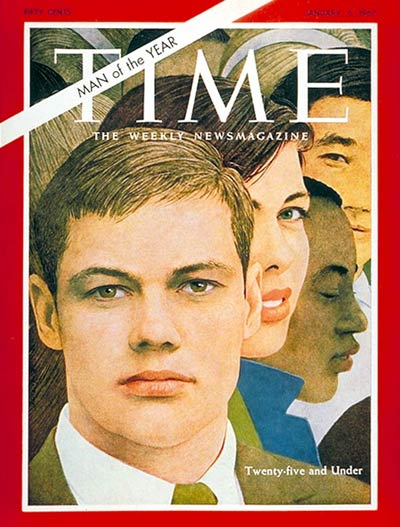
As the new year begins, we look forward to the major anniversaries that will be marked in 2017: the 100th year since the U.S. entered World War I, the 20th year since the death of Princess Diana, the 10th year since the introduction of the iPhone—and much more. But milestone moments do not a year make. Often, it’s the smaller news stories that add up to big history, gradually, over time. With that in mind, in 2017 TIME History will revisit the entire year of 1967, week by week, as it was reported in the pages of TIME, to see how it all comes together.
In the first week of the year 1967—50 years ago—TIME announced that the Man of the Year for 1966 was not one person but rather a generation, the men and women aged 25 and under who had already shown they would remake the world.
“In the closing third of the 20th century, that generation looms larger than all the exponential promises of science or technology: it will soon be the majority in charge. In the U.S., citizens of 25 and under in 1966 nearly outnumbered their elders; by 1970, there will be 100 million Americans in that age bracket,” the magazine explained. “In other big, highly industrialized nations, notably Russia and Canada, the young also constitute half the population. If the statistics imply change, the credentials of the younger generation guarantee it. Never have the young been so assertive or so articulate, so well educated or so worldly. Predictably, they are a highly independent breed, and—to adult eyes—their independence has made them highly unpredictable. This is not just a new generation, but a new kind of generation.”
The story explores the reach of young people (mostly young Americans) in the realms of higher education, war, economics, culture and health. That there was a generation gap between these young people and their parents is taken as a given, but the reasons were many. They could count on living longer, so their adolescence expanded. They had money, time and education to spare. Drugs—illegal ones like LSD and legal ones like the birth-control pill—had changed their daily lives. Military service among young men was something of a foregone conclusion, but their experience of war was different. (The article downplays disagreements about Vietnam and portrays the modern fighting experience as almost cushy.)
Or maybe it was all about Kennedy: having lost the beloved President in 1963, America’s 25-and-unders could look to a vision of the progressive, youthful, changing—and entirely imaginary—society that they might have inherited had JFK lived.
Get your history fix in one place: sign up for the weekly TIME History newsletter
Missing the mark: In its coverage of civilian deaths caused by U.S. military actions in Vietnam, TIME largely stuck with the “right war at the right time” perspective—a view at odds with the current understanding of the war’s lessons. In addition, a story about how German law might protect the identities of former Nazis failed to foresee recent changes that have made it possible to prosecute the last remaining Holocaust-era Nazis.
Choice period detail: A story about the boom in skiing attributes the sport’s popularity to innovations in “metal skis and stretch pants.” While stretch pants do get top billing in the accompanying multi-page, full-color ski-fashion photo story, another item jumps out: There’s also, in all its 1960s glory, a “miniskirt ensemble” for spring skiing.
Ahead of its time: A letter to the editor praises the magazine’s “dignified and accurate” treatment of gender-reassignment surgery, decades before trans rights became a national issue; a story in the world business section looks forward to the coming of a cashless society.
Great vintage advertisement: The Union Pacific railroad touts its access to “America’s vital potato markets.”
Coming up next week: Jan. 13th’s cover subject is Chairman Mao.
More Must-Reads From TIME
- The 100 Most Influential People of 2024
- Coco Gauff Is Playing for Herself Now
- Scenes From Pro-Palestinian Encampments Across U.S. Universities
- 6 Compliments That Land Every Time
- If You're Dating Right Now , You're Brave: Column
- The AI That Could Heal a Divided Internet
- Fallout Is a Brilliant Model for the Future of Video Game Adaptations
- Want Weekly Recs on What to Watch, Read, and More? Sign Up for Worth Your Time
Write to Lily Rothman at lily.rothman@time.com